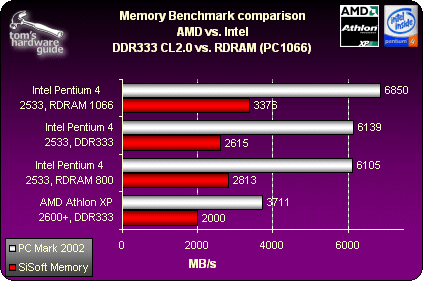Hot Contraband: P4 With 3.6 GHz
Comparison Of All P4 CPUs
| Intel P4 Cores | Willamette | Northwood | Northwood "A" | Prescott |
|---|---|---|---|---|
| Clock Speed | 1.3 - 2.0 GHz | 1.4 - 2.6 GHz | 2.26 - 3.60 GHz | 3.60 GHz - 5.xx GHz |
| FSB clock | 100 MHz | 100 MHz | 133 MHz | 166 MHz |
| FSB speed | Quad-Pumped (400 MHz) | Quad-Pumped (400 MHz) | Quad-Pumped (533 MHz) | Quad-Pumped (666 MHz) |
| L1-Cache (Trace) | 12 K µ-Ops | 12 K µ-Ops | 12 K µ-Ops | ? |
| L1-Cache (Data) | 8 kB | 8 kB | 8 kB | ? |
| L2-Cache (Data) | 256 kB | 512 kB | 512 kB | 512 kB |
| Process | 0.18 µm | 0.13 µm | 0.13 µm | 0.09 µm |
| CPU Die Size | 217 mm2 | 146 mm2 | 146 mm2 | ? |
| Number of Gates | 42 Million | 55 Million | 55 Million | ? |
| Gates per size | 193,548 gates/mm² | 376,712 gates/mm² | 376,712 gates/mm² | ? |
| CPU Core voltage | 1.75 V | 1.50 V | 1.50 V - 1.525 V | 1.25 V |
| Amperage max. | 43 A | 41.7 A | 44.9 A | ? |
| Power consumption max. | 75.3 Watt | 62.6 Watt | 68.4 Watt | ? |
| Hyperthreading | no | no | yes, from 3.06 GHz | yes |
Basis For Discussion: Memory Performance AMD Vs. Intel

The two benchmark suites SiSoft Memory and PC Mark 2002 Memory give clues to the performance of the memory interface. For this, we compared the Pentium 4/2533 with the fastest Athlon XP 2600+ - each on different but comparable platforms equipped with identical peripherals.
The SiSoft test shows that DDR333 memory is marginally slower than 400 MHz RDRAM memory (PC800). The outcome is different with the PC Mark 2002: here, the P4's DDR platform even outstrips the RDRAM system. As before, the RDRAM platform with its 533 MHz memory clock speed is still unmatched, this system winning by a length in every test. Even with the fastest DDR333 memory (CL2), the AMD Athlon XP 2600+ doesn't quite reach the performance of an optimally configured DDR-based P4 system.
Stay on the Cutting Edge
Join the experts who read Tom's Hardware for the inside track on enthusiast PC tech news — and have for over 25 years. We'll send breaking news and in-depth reviews of CPUs, GPUs, AI, maker hardware and more straight to your inbox.
Current page: Comparison Of All P4 CPUs
Prev Page Ride Like The Wind: P4/3600 With 533 MHz RDRAM Next Page Test Setup And Details-
youssef 2010 Now we can see that the ones who expected intel to exceed 4 GHz were completely wrong,as Intel failed to cool its 3.8GHz processor sufficientlyReply
